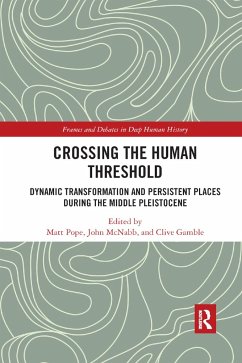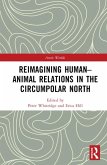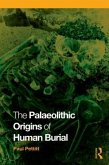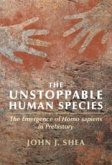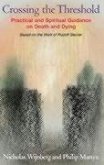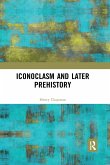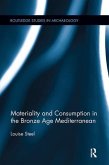Crossing the Human Threshold
Dynamic Transformation and Persistent Places During the Middle Pleistocene
Herausgeber: Pope, Matt; Gamble, Clive; McNabb, John
Crossing the Human Threshold
Dynamic Transformation and Persistent Places During the Middle Pleistocene
Herausgeber: Pope, Matt; Gamble, Clive; McNabb, John
- Broschiertes Buch
- Merkliste
- Auf die Merkliste
- Bewerten Bewerten
- Teilen
- Produkt teilen
- Produkterinnerung
- Produkterinnerung
The volume will provide, for the first time in forty years, a global overview of Late Middle Pleistocene archaeology. It investigates whether this period saw a significant growth in hominin capacities that foreshadow many of the better documented developments associated with the much later modern human revolution. Leading international experts r
Andere Kunden interessierten sich auch für
![Reimagining Human-Animal Relations in the Circumpolar North Reimagining Human-Animal Relations in the Circumpolar North]() Reimagining Human-Animal Relations in the Circumpolar North179,99 €
Reimagining Human-Animal Relations in the Circumpolar North179,99 €![The Palaeolithic Origins of Human Burial The Palaeolithic Origins of Human Burial]() Paul PettittThe Palaeolithic Origins of Human Burial55,99 €
Paul PettittThe Palaeolithic Origins of Human Burial55,99 €![The Unstoppable Human Species The Unstoppable Human Species]() John J. Shea (Stony Brook State University of New York)The Unstoppable Human Species37,99 €
John J. Shea (Stony Brook State University of New York)The Unstoppable Human Species37,99 €![Crossing the Threshold Crossing the Threshold]() Philip MartynCrossing the Threshold12,99 €
Philip MartynCrossing the Threshold12,99 €![Iconoclasm and Later Prehistory Iconoclasm and Later Prehistory]() Henry ChapmanIconoclasm and Later Prehistory56,99 €
Henry ChapmanIconoclasm and Later Prehistory56,99 €![Materiality and Consumption in the Bronze Age Mediterranean Materiality and Consumption in the Bronze Age Mediterranean]() Louise SteelMateriality and Consumption in the Bronze Age Mediterranean71,99 €
Louise SteelMateriality and Consumption in the Bronze Age Mediterranean71,99 €![The Archaeology of Bronze Age Iberia The Archaeology of Bronze Age Iberia]() Gonzalo JimenezThe Archaeology of Bronze Age Iberia59,99 €
Gonzalo JimenezThe Archaeology of Bronze Age Iberia59,99 €-
-
-
The volume will provide, for the first time in forty years, a global overview of Late Middle Pleistocene archaeology. It investigates whether this period saw a significant growth in hominin capacities that foreshadow many of the better documented developments associated with the much later modern human revolution. Leading international experts r
Produktdetails
- Produktdetails
- Verlag: Taylor & Francis Ltd
- Seitenzahl: 288
- Erscheinungstermin: 12. Dezember 2019
- Englisch
- Abmessung: 234mm x 156mm x 17mm
- Gewicht: 488g
- ISBN-13: 9780367878474
- ISBN-10: 036787847X
- Artikelnr.: 58439629
- Verlag: Taylor & Francis Ltd
- Seitenzahl: 288
- Erscheinungstermin: 12. Dezember 2019
- Englisch
- Abmessung: 234mm x 156mm x 17mm
- Gewicht: 488g
- ISBN-13: 9780367878474
- ISBN-10: 036787847X
- Artikelnr.: 58439629
Clive Gamble is Emeritus Professor in the Centre for the Archaeology of Human Origins (CAHO) at the University of Southampton and a Visiting Fellow in the Department of Geography, Royal Holloway. From 2004-11 he was co-director of the British Academy Centenary research project 'Lucy to Language - the Archaeology of the Social Brain'. His recent books include Settling the earth: the archaeology of deep human history (2013) and Thinking Big: how the evolution of social life shaped the human mind (2014), with John Gowlett and Robin Dunbar John McNabb is a member of the Centre for the Archaeology of Human Origins at the University of Southampton. He is interested in the social aspects of technology and material culture with especial reference to the Acheulean and the Lower Palaeolithic/Earlier Stone Age. He has worked extensively in Europe and Africa. Matt Pope is a research fellow at the Institute of Archaeology, University College London and Deputy Director of the Boxgrove Project. He is interested in patterning the use, transportation and discard of artefacts by early humans, taphonomic processes and the geological context of Middle Pleistocene human occupation. He is currently exploring the role of bifacial technology and tool curation behaviour in Lower Palaeolithic hunting strategies and social organization.
i. Dedication and acknowledgements; ii. Contributors; iii. List of Figures
and Tables; iv. Glossary; Section 1: Frames for interpretation: persistence
and thresholds in the Middle Pleistocene; CHAPTER 1. Thresholds in hominin
complexity during the Middle Pleistocene: a persistent places approach;
CHAPTER 2. Thresholds in behaviour, thresholds of visibility: landscape
processes, asymmetries in landscape records and niche construction in the
formation of the Palaeolithic record; Section 2: Regional Case studies:
dynamic transformation in Western Europe and the Levant; CHAPTER 3. The
road to differentiated land use and domestic space in the Middle
Pleistocene of Southwestern Asia; CHAPTER 4. A land of flint and
fallow-deer: human persistence at Middle Pleistocene Qesem Cave; CHAPTER 5.
On the co-evolution of hearth and home-making during the Middle Pleistocene
in the Levant; CHAPTER 6. Land use in Brittany during the Middle
Pleistocene: the example of the persistent place of Menez-Dregan I
(Plouhinec, Finistère); CHAPTER 7. La Cotte de St Brelade: place making,
assemblage and persistence in the Normano-Breton Gulf; CHAPTER 8.
Landscapes of habit and persistent places during MIS 11 in Europe. A return
journey from Britain; CHAPTER 9. Thresholds in lithic technology and human
behaviour during MIS9 in Britain; CHAPTER 10. Neither hot nor cold but dry:
a Northwest European view of Neanderthal environments in late MIS 7 and
beyond; CHAPTER 11. From the Middle to the Upper Pleistocene: origins and
diversification of the Middle Palaeolithic in Northwest France; Section 3:
Global Debates; CHAPTER 12. Everyday tasks demonstrate cognitive complexity
in Africa's Middle Stone Age; CHAPTER 13. A major event in the Middle
Pleistocene?; CHAPTER 14. Persistent places, resident predators and
vigilant faunas: life in Eurasia in Eurasia in the late Middle Pleistocene
and Tables; iv. Glossary; Section 1: Frames for interpretation: persistence
and thresholds in the Middle Pleistocene; CHAPTER 1. Thresholds in hominin
complexity during the Middle Pleistocene: a persistent places approach;
CHAPTER 2. Thresholds in behaviour, thresholds of visibility: landscape
processes, asymmetries in landscape records and niche construction in the
formation of the Palaeolithic record; Section 2: Regional Case studies:
dynamic transformation in Western Europe and the Levant; CHAPTER 3. The
road to differentiated land use and domestic space in the Middle
Pleistocene of Southwestern Asia; CHAPTER 4. A land of flint and
fallow-deer: human persistence at Middle Pleistocene Qesem Cave; CHAPTER 5.
On the co-evolution of hearth and home-making during the Middle Pleistocene
in the Levant; CHAPTER 6. Land use in Brittany during the Middle
Pleistocene: the example of the persistent place of Menez-Dregan I
(Plouhinec, Finistère); CHAPTER 7. La Cotte de St Brelade: place making,
assemblage and persistence in the Normano-Breton Gulf; CHAPTER 8.
Landscapes of habit and persistent places during MIS 11 in Europe. A return
journey from Britain; CHAPTER 9. Thresholds in lithic technology and human
behaviour during MIS9 in Britain; CHAPTER 10. Neither hot nor cold but dry:
a Northwest European view of Neanderthal environments in late MIS 7 and
beyond; CHAPTER 11. From the Middle to the Upper Pleistocene: origins and
diversification of the Middle Palaeolithic in Northwest France; Section 3:
Global Debates; CHAPTER 12. Everyday tasks demonstrate cognitive complexity
in Africa's Middle Stone Age; CHAPTER 13. A major event in the Middle
Pleistocene?; CHAPTER 14. Persistent places, resident predators and
vigilant faunas: life in Eurasia in Eurasia in the late Middle Pleistocene
i. Dedication and acknowledgements; ii. Contributors; iii. List of Figures
and Tables; iv. Glossary; Section 1: Frames for interpretation: persistence
and thresholds in the Middle Pleistocene; CHAPTER 1. Thresholds in hominin
complexity during the Middle Pleistocene: a persistent places approach;
CHAPTER 2. Thresholds in behaviour, thresholds of visibility: landscape
processes, asymmetries in landscape records and niche construction in the
formation of the Palaeolithic record; Section 2: Regional Case studies:
dynamic transformation in Western Europe and the Levant; CHAPTER 3. The
road to differentiated land use and domestic space in the Middle
Pleistocene of Southwestern Asia; CHAPTER 4. A land of flint and
fallow-deer: human persistence at Middle Pleistocene Qesem Cave; CHAPTER 5.
On the co-evolution of hearth and home-making during the Middle Pleistocene
in the Levant; CHAPTER 6. Land use in Brittany during the Middle
Pleistocene: the example of the persistent place of Menez-Dregan I
(Plouhinec, Finistère); CHAPTER 7. La Cotte de St Brelade: place making,
assemblage and persistence in the Normano-Breton Gulf; CHAPTER 8.
Landscapes of habit and persistent places during MIS 11 in Europe. A return
journey from Britain; CHAPTER 9. Thresholds in lithic technology and human
behaviour during MIS9 in Britain; CHAPTER 10. Neither hot nor cold but dry:
a Northwest European view of Neanderthal environments in late MIS 7 and
beyond; CHAPTER 11. From the Middle to the Upper Pleistocene: origins and
diversification of the Middle Palaeolithic in Northwest France; Section 3:
Global Debates; CHAPTER 12. Everyday tasks demonstrate cognitive complexity
in Africa's Middle Stone Age; CHAPTER 13. A major event in the Middle
Pleistocene?; CHAPTER 14. Persistent places, resident predators and
vigilant faunas: life in Eurasia in Eurasia in the late Middle Pleistocene
and Tables; iv. Glossary; Section 1: Frames for interpretation: persistence
and thresholds in the Middle Pleistocene; CHAPTER 1. Thresholds in hominin
complexity during the Middle Pleistocene: a persistent places approach;
CHAPTER 2. Thresholds in behaviour, thresholds of visibility: landscape
processes, asymmetries in landscape records and niche construction in the
formation of the Palaeolithic record; Section 2: Regional Case studies:
dynamic transformation in Western Europe and the Levant; CHAPTER 3. The
road to differentiated land use and domestic space in the Middle
Pleistocene of Southwestern Asia; CHAPTER 4. A land of flint and
fallow-deer: human persistence at Middle Pleistocene Qesem Cave; CHAPTER 5.
On the co-evolution of hearth and home-making during the Middle Pleistocene
in the Levant; CHAPTER 6. Land use in Brittany during the Middle
Pleistocene: the example of the persistent place of Menez-Dregan I
(Plouhinec, Finistère); CHAPTER 7. La Cotte de St Brelade: place making,
assemblage and persistence in the Normano-Breton Gulf; CHAPTER 8.
Landscapes of habit and persistent places during MIS 11 in Europe. A return
journey from Britain; CHAPTER 9. Thresholds in lithic technology and human
behaviour during MIS9 in Britain; CHAPTER 10. Neither hot nor cold but dry:
a Northwest European view of Neanderthal environments in late MIS 7 and
beyond; CHAPTER 11. From the Middle to the Upper Pleistocene: origins and
diversification of the Middle Palaeolithic in Northwest France; Section 3:
Global Debates; CHAPTER 12. Everyday tasks demonstrate cognitive complexity
in Africa's Middle Stone Age; CHAPTER 13. A major event in the Middle
Pleistocene?; CHAPTER 14. Persistent places, resident predators and
vigilant faunas: life in Eurasia in Eurasia in the late Middle Pleistocene

